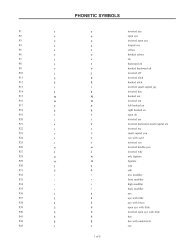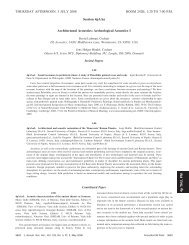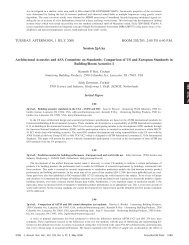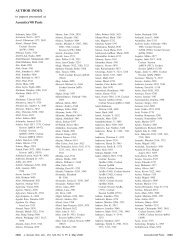Tuesday afternoon, 11 November - The Acoustical Society of America
Tuesday afternoon, 11 November - The Acoustical Society of America
Tuesday afternoon, 11 November - The Acoustical Society of America
You also want an ePaper? Increase the reach of your titles
YUMPU automatically turns print PDFs into web optimized ePapers that Google loves.
2:30<br />
2pBB5. Time reversal acoustic receiver. Laurent Fillinger Artann Labs.,<br />
1459 Lower Ferry Rd., Trenton, NJ 08618 and Stevens Inst. <strong>of</strong> Technologies,<br />
Hoboken, NJ 07030, Yegor Sinelnikov ProRhythm, Ronkonkoma,<br />
NY <strong>11</strong>779, Alexander Sutin, and Armen Sarvazyan Artann Labs., Trenton,<br />
NJ 08618<br />
<strong>The</strong> time reversal acoustics TRA principle has been employed for focusing<br />
ultrasonic waves in various biomedical and industrial applications.<br />
TRA-based ultrasonic transmitters have numerous advantages over conventional<br />
methods <strong>of</strong> ultrasound focusing such as an ability to effectively focus<br />
and steer focal spot with a transmitter comprising even a single piezoelectric<br />
transducer. In this study it is shown that such TRA focusing systems with a<br />
small number <strong>of</strong> transducers can also work in the receiving mode and detect<br />
both active and passive targets with a spatial resolution close to a half<br />
wavelength. <strong>The</strong> feasibility tests were conducted using two types <strong>of</strong> TRA<br />
receivers. <strong>The</strong> first TRA receiver comprising a water-filled reverberator with<br />
a few 600 kHz piezoceramic elements attached was used for the detection <strong>of</strong><br />
the signal radiated by a miniature 1 mm emitter in a water tank. It was<br />
shown that the TRA receiver can detect the position <strong>of</strong> this point emitter<br />
with accuracy better than 1 mm. <strong>The</strong> second test was conducted with an<br />
acoustic reverberator made <strong>of</strong> series <strong>of</strong> thin randomly shaped membranes<br />
and a single disk transducer with a frequency <strong>of</strong> 3.3 MHz. This TRA receiver<br />
allowed the localization <strong>of</strong> a reflecting target illuminated by a plane<br />
acoustic wave with resolution also better than 1 mm.<br />
2:45<br />
2pBB6. Identifying the inertial cavitation threshold in a vessel phantom<br />
using focused ultrasound and microbubbles. Yao-Sheng Tung, James<br />
Choi, Shougang Wang Dept. <strong>of</strong> Biomedical Eng., Columbia Univ., 351<br />
Eng. Terrace, 1210 Amsterdam Ave., New York, NY 10027,<br />
YT2235@columbia.edu, Jameel Feshitan, Mark Borden and Elisa Kon<strong>of</strong>agou<br />
Columbia Univ., New York, NY 10027<br />
Unveiling the mechanism behind the blood brain barrier using focused<br />
ultrasound FUS and microbubbles is essential for brain molecular delivery.<br />
Here, B-mode imaging and rf signals were acquired to pinpoint the threshold<br />
for inertial cavitation during FUS with microbubbles. A cylindrical hole <strong>of</strong><br />
800 µm in diameter was generated inside a polyacrylamide gel to simulate a<br />
brain arterial vessel. Definity ® Lantheus Medical Imaging, USA microbubbles<br />
with a 1.1–3.3 µm-diameter and 1,2-distearoyl-sn-glycero-3phosphocholine<br />
DSPC shelled microbubbles with a 1–2-µm-diameter<br />
were injected prior to sonication frequency: 1.525 MHz; pulse length: 100<br />
cycles; PRF: 1 kHz; pulse duration: 40 ms. <strong>The</strong> cavitation response was<br />
passively detected using a 7.5-MHz single-element transducer, confocal<br />
with the FUS transducer, and a one-dimensional linear array transducer<br />
placed perpendicular to the FUS beam. <strong>The</strong> broadband spectral response <strong>of</strong><br />
the acquired rf signals and the B-mode images detected the occurrence and<br />
location <strong>of</strong> inertial cavitation, respectively. Findings indicated that the rarefactional<br />
pressure threshold was approximately 0.53 MPa for the definity<br />
and 0.69 MPa for the DSPC-shelled microbubbles. Further studies will vary<br />
the vessel diameter and microbubble size to determine their role in the pressure<br />
threshold. This work was supported by NIH Grant No. R21EY018505<br />
and NSF CAREER 0644713. <strong>The</strong> authors thank Jennifer Hui for bubble<br />
characterization.<br />
3:00<br />
2pBB7. Single transmitter time reversal focusing characterization using<br />
cross-correlation method. Yegor Sinelnikov and Andrey Vedernikov<br />
ProRhythm Inc., 105 Comac St., Ronkonkoma, NY <strong>11</strong>770<br />
Acoustic focusing with reverberating acoustic cavities based on the time<br />
reversal acoustic principle has been demonstrated in a range <strong>of</strong> medical applications<br />
from three-dimensional imaging to the generation <strong>of</strong> high pressure<br />
therapeutic pulses for the destruction <strong>of</strong> kidney and gallbladder stones in the<br />
human body. We investigate acoustic focusing in a system comprised <strong>of</strong> a<br />
single transmitter and a layered membrane reverberator. <strong>The</strong> system is capable<br />
<strong>of</strong> achieving focal peak acoustic pressures up to 0.4 MPa with less<br />
than 1 mm focal spot and steering range up to 20 mm. Focusing in the frequency<br />
range between 0.5 and 4 MHz is investigated. <strong>The</strong> parametric investigation<br />
<strong>of</strong> various membrane configurations is performed by a conventional<br />
time reversal technique with a hydrophone. In addition, we propose the<br />
cross-correlation <strong>of</strong> hydrophone signals as a method <strong>of</strong> evaluating the system<br />
focusing properties without conducting the actual time reversal focusing<br />
experiment. <strong>The</strong> cross-correlation method predicts the focal spot dimensions<br />
for the layered reverberator single transmitter system that compares well<br />
with experiment and theory. An important implication is the possibility to<br />
use inverse filtering to construct signals <strong>of</strong> the desired waveform with a low<br />
spatial peak pressure amplitude that can enhance the cell’s permeability toward<br />
macroparticle uptake.<br />
3:15<br />
2pBB8. Information theoretic approaches to ultrasonic system design:<br />
Beamforming with interative spatial filters. Nghia Nguyen Dept. <strong>of</strong> ECE<br />
and Beckman Inst., Univ. <strong>of</strong> UIUC, 405 N. Mathews, Urbana, IL 61801,<br />
nnguyen6@uiuc.edu, Craig Abbey Univ. <strong>of</strong> California at Santa Barbara,<br />
Santa Barbara, CA 93106, and Michael Insana Univ. <strong>of</strong> UIUC, Urbana, IL<br />
61801<br />
First-principles approaches to the design <strong>of</strong> medical ultrasonic imaging<br />
systems for specific visual tasks are being explored. <strong>The</strong> study focuses on<br />
breast cancer diagnosis and is based on the ideal observer concept for visual<br />
discrimination tasks, whereby clinical tasks are expressed mathematically as<br />
likelihood functions. Realistic approximations to the ideal strategy for each<br />
visual task are proposed to maximize the diagnostic information content <strong>of</strong><br />
the images. Based on previous studies Abbey et al., IEEE Trans. Med. Imaging<br />
25, 198–209 2006, it is known that the Wiener filter approach to<br />
beamforming, derived as a stationary approximation <strong>of</strong> the ideal observer, is<br />
limited for low-contrast, large area lesion discrimination. In this study an<br />
adaptive iterative Wiener filter coupled to a segmentation algorithm is developed<br />
to optimally beamform and process radio-frequency rf signals.<br />
<strong>The</strong> segmentation is achieved by applying a Markov random field approach.<br />
Performance is measured by comparing proportion correct in humanobserver<br />
studies with the ideal observer and its approximations as required<br />
for an estimate <strong>of</strong> discrimination efficiency. It is found that by adapting to<br />
local statistical properties <strong>of</strong> the rf signal the iterative Wiener filter increases<br />
visual discrimination efficiency where the Wiener filter and conventional<br />
beamformers fail. Work supported by the NCI/NIH.<br />
2486 J. Acoust. Soc. Am., Vol. 124, No. 4, Pt. 2, October 2008 156th Meeting: <strong>Acoustical</strong> <strong>Society</strong> <strong>of</strong> <strong>America</strong><br />
2486







